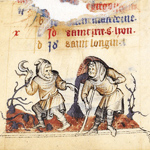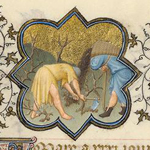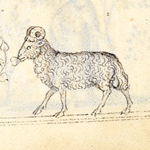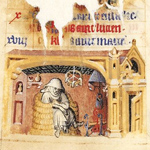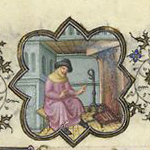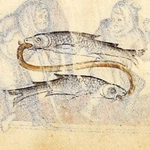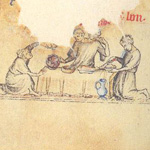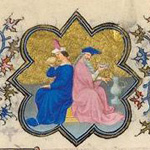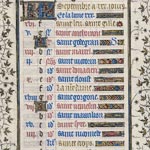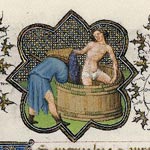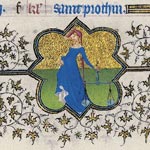Posts Tagged ‘Belles Heures’
Friday, March 11, 2011
At certain times of the year in the medieval rural landscape, it would have been common to see plump sheaves of grain standing in sunny fields like so many golden tokens of agricultural wealth and prosperity, as numerous depictions???even in some of the most sumptuous manuscripts of the Middle Ages, such as the Belles Heures of the duke of Berry???attest. At harvest, the wheat was cut at the base of the stalk with a sickle and then gathered up in large armfuls and tied about the middle. The resulting bundles were left spaced and standing upright in the fields, which allowed them to dry even if it happened to rain before they could carted off for threshing.
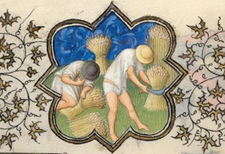

Details of illuminations from Folio 8r and Folio 9r from the Belles Heures of Jean de France, duc de Berry, 1405???1408/9.
Read more »
Tags: barley, Belles Heures, blazon, Bolton, caraway, carrot, Cheshire, Comyn, cumin, Cuminum cyminum, garb, Geoffrey Chaucer, gold, grain, Grosvenor, heraldic, heraldry, John of Gaunt, oat, Owain Glynd??r, parsley, rye, Scrope, sheaf, sheaves, shield, wheat
Posted in Plants in Medieval Art | Comments (1)
Friday, March 5, 2010
Above, from left to right: Detail of the activity for the month from the March calendar page of The Hours of Jeanne d’??vreux, ca. 1324???28; detail of the activity for March from the Belles Heures of Jean of France, duc de Berry, 1405???1408/1409; detail of the zodiacal symbol Aries from The Hours of Jeanne d’??vreux. See the Heilbrunn Timeline of Art History to learn more about manuscript illumination in Northern Europe, or see special exhibitions for information about the exhibition “The Art of Illumination: The Limbourg Brothers and the Belles Heures of Jean de France, Duc de Berry” (on view at the Main Building March 2 through June 13, 2010).
The month of March marked the return to work in the fields for the medieval peasant, and the pruning, cultivation, and manuring of the vines was the first task of the agricultural year???these essential chores constitute the activity almost always chosen to represent March in medieval calendars. (The spring ploughing of the fields might be shown instead in books of hours made in locales where wine was not produced.) Read more »
Tags: Belles Heures, book of hours, calendar, Jeanne d?????vreux, March
Posted in The Medieval Calendar | Comments (2)
Friday, February 19, 2010
Above, from left to right: Detail of the activity for the month from the February calendar page of ??The Hours of Jeanne d’??vreux, ca. 1324???28; detail of the activity for February from the Belles Heures of Jean de France, Duc de Berry, 1405???1408/1409; detail of the zodiacal symbol Pisces from The Hours of Jeanne d’??vreux. See the Heilbrunn Timeline of Art History to learn more about manuscript illumination in Northern Europe, or see special exhibitions for information about the exhibition “The Art of Illumination: The Limbourg Brothers and the Belles Heures of Jean de France, Duc de Berry” (on view at the Main Building March 2 through June 13, 2010).
In the medieval calendar tradition, the month of February is frequently represented by a solitary male figure seated before a fire; he may or may not be cooking his meal as he warms himself. A table set with a few dishes is sometimes placed by the fire, a variant on the theme of feasting common to both January and February. (See “The January Feast,” January 15, 2010). Read more »
Tags: Belles Heures, book of hours, calendar, February, Jeanne d?????vreux, winter
Posted in The Medieval Calendar | Comments (2)
Friday, January 15, 2010
Above, from left to right: Detail of the January calendar page from The Hours of Jeanne d’??vreux, ca. 1324???28; detail of the activity for the month of January from The Belles Heures of Jean de France, Duc de Berry, 1405???1408/1409; Ewer with Wild Man Finial (detail), late 15th century, German, The Metropolitan Museum of Art, New York, The Cloisters Collection, 1953 (53.20.2).
In the Middle Ages, the?? Christian liturgical year, and not the old Roman calendar, determined the date on which the new year began. The date used differed depending on the??period and locale, and coincided with either the Nativity on December 25 or the Annunciation on March 25. However, throughout the Middle Ages, the ancient Roman tradition of January festivities in celebration of the New Year continued unabated. Banquets and gifts were given, and folk rites intended to ensure good fortune and plenty and to stave off disaster and want were performed. The Church discouraged such practices, but found the celebration of the New Year more difficult to suppress than any other calendar tradition inherited from pagan antiquity. Read more »
Tags: Belles Heures, book of hours
Posted in The Medieval Calendar | Comments (0)
Friday, September 4, 2009
Above, from left to right: Calendar page for September from the Belles Heures of Jean de France, Duc de Berry, 1405???1408/1409. Pol, Jean, and Herman de Limbourg (Franco-Netherlandish, active in France, by 1399???1416). French; Made in Paris. The Metropolitan Museum of Art, New York, The Cloisters Collection, 1954 (54.1.1); detail of the activity for the month; detail of the zodiacal symbol Libra. See the Collection Database to learn more about this work of art.
Images of peasants sowing, reaping, threshing, winnowing, and storing wheat in the appropriate months dominate the medieval calendar tradition???the only agricultural product that rivals wheat???s importance in the cycle of the year is the wine grape, Vitis vinifera. (For more on wine grapes and wine in the Middle Ages, see ???Grapevines at The Cloisters,??? March 13.). Read more »
Tags: Belles Heures, grapes, Libra, September, Vitis vinifera, wine
Posted in The Medieval Calendar | Comments (1)
Friday, May 1, 2009
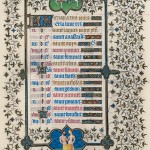

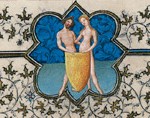
Above, from left to right: Calendar page for May, from The Belles Heures of Jean de France, Duc de Berry, 1405???1408/1409. Pol, Jean, and Herman de Limbourg (Franco-Netherlandish, active in France, by 1399???1416). French; Made in Paris. The Metropolitan Museum of Art, New York, The Cloisters Collection, 1954 (54.1.1); detail of the activity for the month; detail of the zodiacal symbol Gemini. See the Collection Database to learn more about this work of art.
Riding or walking, in companies of green-clad couples like the courtiers of King Arthur or the Duke de Berry, or by twos, or all alone, like the Dreamer of the Roman de la Rose or the falconer of the Belles Heures, there are many variations on the medieval set piece of the May morning???s outing to the greenwood.
Read more »
Tags: Belles Heures, Crataegus monogyna, hawthorn, May, maying
Posted in The Medieval Calendar | Comments (2)
Friday, January 9, 2009

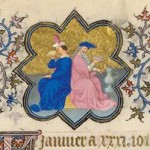
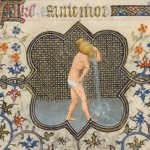
Above left to right: Calendar page from The Belles Heures of Jean de France, Duc de Berry, 1405???1408/1409. Pol, Jean, and Herman de Limbourg (Franco-Netherlandish, active in France, by 1399???1416). French; Made in Paris. The Cloisters Collection, 1954 (54.1.1). Center: Detail of the activity for the month; Right: Detail of the zodiacal symbol Aquarius. See the Collection Database to learn more about this work of art.
| Januar |
By thys fyre I warme my handys; |
| Februar |
And with my spade I delfe my landys. |
| Marche |
Here I sette my thynge to sprynge, |
| Aprile |
And here I here [hear] the fowlis synge. |
| Maij |
I am as lyght as byrde on bowe, |
| Junij |
And I wede my corne well I-now [enough] |
| Julij |
With my sythe [scythe] my meade [meadow] my mead I [mow]; |
| Auguste |
And here I shere my corne full low. |
| September |
With my flayll I erne my brede, |
| October |
And here I sawe [sow] my whete so rede. |
| November |
At Martynesmasse I kyll my swine; |
| December |
And at Cristesmasse I drynke redde wyne. |
(Bridget Henisch, The Medieval Calendar Year, 1999)
Read more »
Tags: Belles Heures, calendar, feasting, January
Posted in The Medieval Calendar | Comments (5)



